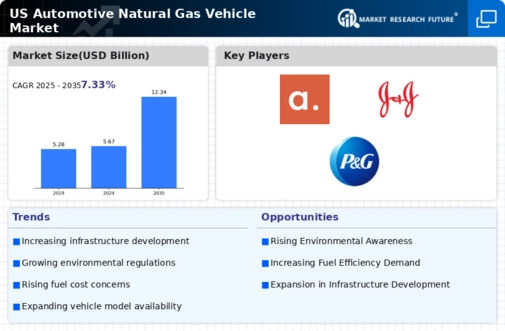The US Automotive Natural Gas Vehicle Market presents a dynamic landscape characterized by increasing regulatory pressures to reduce emissions and a growing demand for alternative fuel vehicles. As major automakers pivot towards sustainable solutions, the competition intensifies among established players and new entrants alike. The market's growth is propelled by technological advancements in natural gas engine designs and the development of a robust refueling infrastructure. Companies are not just vying for market share but also for technological supremacy, collaborating with energy providers and investing in research and development to innovate and enhance vehicle offerings.
Competitive insights reveal how each player leverages its strengths, such as brand reputation, distribution networks, and consumer loyalty, to carve out a niche in this evolving market.
Toyota Motor Corporation has a considerable presence in the US Automotive Natural Gas Vehicle Market and has strategically positioned itself as a leader in sustainable transportation solutions. The company's strengths lie in its extensive experience in hybrid technology, which it seamlessly integrates with natural gas vehicle offerings. Toyota's commitment to research and development has enabled it to develop vehicles that deliver impressive fuel efficiency and reduced emissions while maintaining performance reliability. In addition to its technological prowess, Toyota's established dealer network ensures broad accessibility for customers, enhancing its competitive edge.
The company's long-term sustainability vision and proactive approach to engaging with regulatory bodies further strengthens its foothold in the natural gas market.
Nissan is also a key player in the US Automotive Natural Gas Vehicle Market, with a focused agenda on enhancing its portfolio of natural gas vehicles. The company's prominent offerings include models designed for commercial fleets, which often emphasize cost-effectiveness and lower operational expenses. Nissan's strengths in this market are tied to its robust engineering capabilities and commitment to environmental stewardship. The company has been involved in various partnerships aimed at expanding its range of natural gas vehicles while simultaneously increasing its market reach.
Recent mergers and acquisitions have bolstered Nissan's resources and technological advancements, allowing it to stay competitive while addressing the growing consumer demand for cleaner transportation options. With a solid reputation for reliability and performance, Nissan continues to leverage its market presence to cater to a customer base eager for innovative fuel solutions.













